Rochester, New York is facing some truly tough times. Many of the large manufacturing companies that once were its leading employers (such as Eastman Kodak Company, Xerox Corporation, and Bausch and Lomb) have made significant cutbacks. Between 2000 and 2005, private sector employment in the area dropped by 4.1%, and the city’s population contracted by 4.0%.[1]
For youth to become successful adults in this challenging economic environment, education has to play a key role. But sadly Rochester’s kids are falling painfully short in school. Among eighth graders, 90% have failed the math standards assessment and 80% have failed the English assessment.[2] On average 49% of seventh graders fail to graduate with their class.[3]
Rochester-based Hillside Work-Scholarship Connection (HW-SC) is working to improve this picture. The organization pairs students with professional Youth Advocates who provide mentoring and other types of support in school, at home, and at work. Many of the students are paired with local employers for exposure to meaningful part-time work experience. By supporting at-risk students in settings where they are most likely to struggle and where they have the most to gain, HW-SC helps youth stay in school, achieve academic success, earn their high-school diploma or GED, and acquire the habits and skills that will prepare them for success at work and in life.
The organization’s origins trace back to 1987, when the Urban League of Rochester urged the business community to become more involved with the city’s struggling school system. In response, Wegmans Food Markets created the Wegmans Work-Scholarship Connection Program. The program became the Hillside Work-Scholarship Connection in 1996 when it spun off as an independent nonprofit and affiliated with the Hillside Family of Agencies (HFA). (See the appendix for more detail about HW-SC’s history.)
HW-SC has received numerous accolades over the years for its success working with youth. A third-party evaluation completed in 2004 provided concrete proof of the organization’s results, with HW-SC youth graduating from high school at a rate nearly double that of peers not in the program (61% versus 31%).[4]
By 2005, under the leadership of HW-SC Executive Director Annette Gantt and with the active involvement of HFA Chief Executive Officer Dennis Richardson and HFA Chief Operating Officer Clyde Comstock, HW-SC had become the largest drop-out prevention program in Rochester. The organization was serving over 1,000 Rochester youth, but in the minds of Gantt and her team, it wasn’t enough. They believed there were were thousands more Rochester youth in need of the HW-SC’s services.
With encouragement from the Monroe County Executive’s Office, the Rochester City School District, the Mayor’s Office, the Rochester Business Alliance, and the local legislative delegation, HW-SC committed to expanding the program to serve significantly more youth, with the ultimate goal of tripling by 2010. Community supporters and HW-SC board members believed that tripling would not only make a major difference for the individual youth served, but also give HW-SC sufficient critical mass to influence the overall culture of the city’s high schools.
Spring of 2006 found HW-SC still eager to pursue its plans for significant growth, but also sobered by the challenges inherent in growing so quickly. Early efforts to identify financial and other crucial forms of support had met with limited success, and the enthusiasm of community stakeholders had not yet translated into a marked increase in tangible assistance. Gantt and her team were beginning to wonder how much room there was to grow in Rochester.
Under these circumstances, and with the financial support of the Edna McConnell Clark Foundation, HW-SC engaged with Bridgespan to assess its full potential for growth. The factors that would in large part define HW-SC’s growth potential quickly became clear. Finding more participants for the program was not among them: Even if the program tripled in size, HW-SC would be working with only 30% of its at-risk target population. Rather, the availability of both funding and meaningful part-time job opportunities for youth appeared to be the main constraints. Learning more about these two areas would become the focus of the HW-SC’s and Bridgespan’s work together.
Key Questions
A team assembled to develop HW-SC’s growth plan. Joining Gantt, Richardson, and Comstock were HFA Chief Financial Officer Paul Perrotto, HW-SC Quality Assurance and Improvement Manager Rod Green, and five Bridgespan consultants. Among the questions the team addressed over a period of five months:
- How many additional part-time job opportunities could HW-SC secure via partnerships with area employers?
- What current and new funding sources could HW-SC access to support growth?
- Putting these two considerations together, what was HW-SC’s full growth potential in Rochester?
Assessing Job Prospects
HW-SC had maintained a deep commitment over the years to providing youth with valuable work experience. The organization’s staff and board alike believed that the ability to succeed in a work environment was central to leading a productive life after high-school graduation. All employment-age HW-SC youth who met certain criteria were given part-time jobs with local employers. The criteria included achieving specific academic and attendance thresholds (which some 44% of the youth did during the 2005-06 school year) and participating in an employment training course.
Efforts were underway to extend the part-time job component of the program to a greater percentage of the HW-SC employment-age youth. More specifically, HW-SC was providing employment training to increasing numbers of students. Making this change while tripling the program’s size would require the organization to identify more than 1,000 new job slots by 2010.
Finding all those job slots was a daunting proposition. As of early 2006, HW-SC’s partnerships with area employers translated to 230 part-time jobs for youth. Nearly 90% of those jobs came from Wegmans, which like most supermarkets commonly employed teenagers in part-time positions (see exhibit 1). The remaining 10% were with other area employers, none of which provided more than five slots at a time. Both of these sources appeared to be tapped out: Wegmans had stated that it could only commit a small number of additional jobs, and just a couple of the current smaller employers showed prospects for growth. Moreover, dedicated efforts by the HW-SC board and key community stakeholders to cultivate new relationships were bearing little fruit.
Exhibit 1: Hillside Work-Scholarship Connection’s part-time job mix by employer
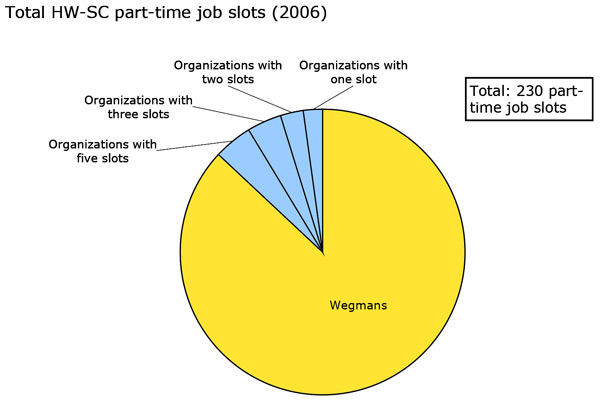
Had HW-SC reached the limit for meaningful jobs in Rochester? To find out, the team began by taking a detailed look at Wegmans. Perhaps there was more opportunity with this key employer than appeared at first blush.
One way to get a firmer handle on the possibilities with Wegmans was to consider HW-SC’s share of all Wegmans jobs held by Rochester youth. A high share would imply HW-SC likely was tapped out at Wegmans; a low one would suggest room to grow. The team collected the necessary information, and, in a surprise to Wegmans and HW-SC leadership alike, the data showed that HW-SC youth held only 11% of the jobs—far lower than expected (see exhibit 2).
Exhibit 2: Profile of Wegmans jobs
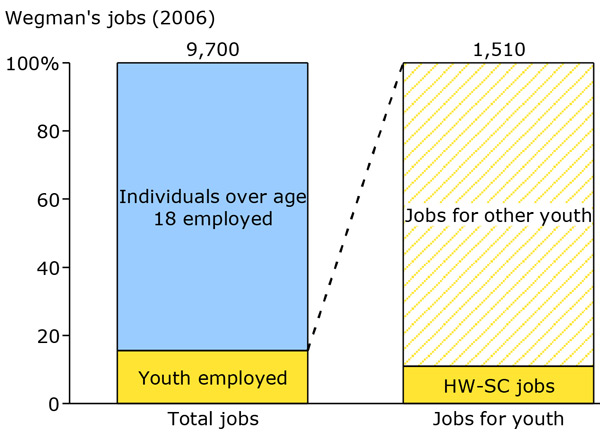
The finding provoked renewed conversations about growth with Wegmans. In the past, there hadn’t been enough HW-SC youth to fill more than 200 Wegmans job slots at one time, so Wegmans management naturally assumed 200 to be the ceiling. With HW-SC’s aggressive growth goals, however, there would be no shortage of HW-SC candidates for Wegmans jobs. In light of this newfound understanding, the HW-SC and Wegmans teams revised their projections. Ultimately, the Wegmans team committed to doubling to 400 the number of jobs offered to HW-SC students by 2010.
With tripling still in its sights, the team pursued the remaining two options: HW-SC’s other 13 employer partners and potential new employer partners in the Rochester area. To help evaluate new opportunities, the team decided to crystallize what the “secret sauce” was behind HW-SC’s great success with Wegmans. They then would prioritize opportunities that matched well with the Wegmans-based success factors.
Accordingly, the project team set out to interview Wegmans and HW-SC staff about their take on their relationship. In speaking with representatives from both groups, it quickly became apparent that success was as much about what the program participants gave back to their employer as it was about what the job offered the HW-SC youth. The HW-SC/Wegmans partnership was so healthy in large part because it was one of true mutual benefit. HW-SC staff reported that program participants consistently praised Wegmans as an employer. The kids described a positive working environment where they were welcomed into the Wegmans “family” and were able to build tangible skills. Value flowed in the other direction as well. Store managers noted that HW-SC youth were on average stronger contributors than their peers. In fact, Wegmans’ retention rate for HW-SC youth was 84%, which was 15 percentage points higher than the rate for other youth workers.[5] In short, the HW-SC/Wegmans partnership worked so well because through it HW-SC youth found meaningful and rewarding employment, and Wegmans fulfilled a major business need. The team went on to codify a full set of job screening criteria based on the Wegmans example (see exhibit 3).
Exhibit 3: Hillside Work-Scholarship Connection’s criteria for meaningful part-time jobs
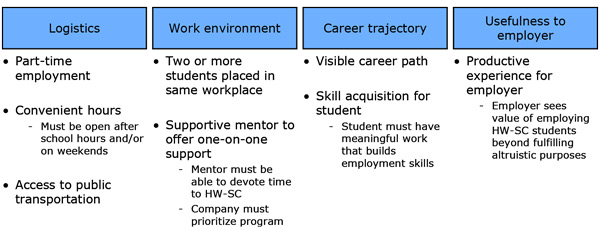
With this winning formula solidified, the team probed its current relationships with other employers for similar win-win situations. Interestingly, however, when the team asked these smaller employer partners why they were committed to employing HW-SC youth, many sounded a somewhat different refrain. Instead of meeting a pre-existing business need, they were motivated primarily by charitable intentions and their sense of civic duty. And while the HW-SC youth were indeed making positive contributions at their companies, in many cases the employers had needed to create positions expressly for them. Were it not for HW-SC’s mission and the need for quality jobs for its youth, some employers said they might not employ part-time youth at all.
Therein lay the rub. These smaller employers were—and would continue to be—essential partners in the HW-SC mix. In addition to providing jobs that allowed the kids to engage in productive work and giving them a range of options from which to choose, they were staunch supporters of the program and advocates for it in the community. But the positions they could offer were simply not scalable to large numbers of youth. Lining up enough of these employers to meet the growth goals would take far too much time and energy on the part of HW-SC staff.
Accordingly, the team next proceeded to scan the Rochester landscape for other potential large partners, and quickly honed in on employers that already had large numbers of employees. Using the list of the county’s top 20 employers, they applied the Wegmans-based screening criteria to identify top prospects. Rising to the top were hospitals—a group in which the HW-SC board and staff had long been interested—and noticeably few others.
Beyond local hospitals’ potential to employ a large number of youth on a part-time basis, they had a few other things going for them. They needed unskilled but hardworking employees, and their night and weekend schedules meant that they were accustomed to using part-time workers. Moreover, many were located close to public transportation, helping to make them an economical option as well. And there were early signs that hospitals would be receptive to the notion of employing HW-SC youth: Three hospitals had begun experimenting with the idea by hiring one HW-SC youth each during the 2005-06 school year.
HW-SC’s priorities for growing its jobs significantly were now clear: collaborate with Wegmans to ramp up their HW-SC jobs to 400; pursue partnerships with a limited number of smaller community employers who could each provide both a few high-quality jobs and essential community support; and establish deep partnerships with area hospitals. The team projected that, all in, these three sources would translate to HW-SC’s number of job slots increasing from 230 to approximately 580 by 2010 (see exhibit 4).
Exhibit 4: Projected part-time job slots
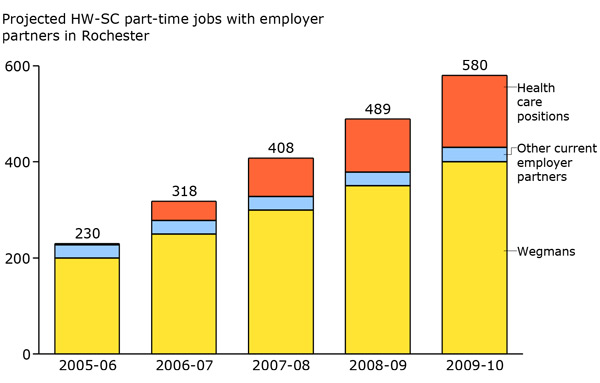
Investigating Potential Funding Sources
The road to tripling HW-SC’s funding sources promised to be equally challenging. HW-SC’s funding had grown in several large jumps over the years as the organization accessed new pools of government money. Most of these new government sources were relatively short-lived, however. By fiscal year 2006, the majority of HW-SC’s government funding was coming from one fairly stable New York State source, and the organization’s total revenue had reached $3.7 million (see exhibit 5).
Exhibit 5: Hillside Work-Scholarship Connection revenue mix over time
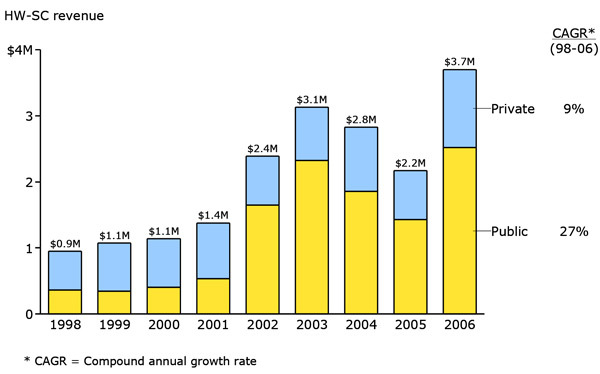
Where funds for further growth would come from was unclear. County officials had advised HW-SC that its current major government source was unlikely to offer much room for growth, and corporate and philanthropic giving in Rochester had been deeply affected by the city’s economic woes. Was there sufficient funding to support HW-SC’s growth goals?
To find out, the joint HW-SC/Bridgespan team assessed the potential for growth in HW-SC’s current funding streams and explored the viability of potential new streams.
Private Sources
Several private funding sources—the majority individual donors and corporations with ties to the Wegmans family and its contacts within the community—had provided HW-SC with reliable levels of support over the years. These funds had grown in absolute terms, climbing from just under $600,000 in 1998 to nearly $1.2 million in 2006. They had not, however, kept pace with the organization’s government monies. Whereas private funds accounted for over 60% of HW-SC’s funding in 1998, by 2006 that percentage had shrunk to a little less than a third.
Based on their in-depth knowledge of the individual donors and corporations in the community, HW-SC’s leaders believed that those funding sources were likely to continue on their current trajectory: slow and steady growth. They would be critical sources of funding but not sufficient to support rapid growth.
Foundations were more of a question mark, given that they accounted for only a small portion of HW-SC’s private funding. Accordingly, the project team set out to test the foundation funding waters for untapped potential. Using Foundation Center’s online database, they conducted an exhaustive search of foundation grants to Rochester-based organizations—with disappointing results.[6] Total foundation funding to Rochester nonprofits was quite low, ranging between $12.3 million and $17.3 million annually from 2001 to 2004. Moreover, annual foundation funding to all area organizations that worked on social challenges similar to those HW-SC addressed was frequently less than HW-SC’s annual budget. Any reliance on foundation funding for growth would likely need to come from new foundations not already making youth-related grants in Rochester—clearly an uphill battle.
Government Funding
For government sources of funding, the team focused on HW-SC’s large New York State source. As described earlier, HW-SC had been advised by public officials that it was close to tapping out this particular funding stream. No public source of data was available, however, to clearly define what that actual limit might be, so the team began to investigate the specific mechanics of the funding stream.
Multiple interviews with various state and county officials proved necessary to develop a comprehensive understanding of the funding stream. Each interviewee held a different piece of the puzzle that when put together revealed a complex structure with detailed matching and eligibility rules—and unexpected room for growth. The actual amounts available were significant enough to at least double HW-SC’s funding levels over the next three to four years—if, that is, HW-SC were able to develop sufficient support among key public officials.
Looking beyond this one source to other potential government funding streams, the team methodically scanned relevant state and county agency programs. While no large new sources surfaced, several smaller opportunities emerged. Collectively they represented a chance for HW-SC to diversify its public funding base, as well as a way to “get its foot in the door” of government funding streams that might expand in the future.
At the federal level, several of the senior leaders at HFA were working to lay the groundwork for future funding. For example, they were engaging lobbying support and meeting with representatives from the leading federal agencies and associations committed to improving the graduation rates of America’s youth. This route had a longer time horizon, but HFA hoped to be able to position HW-SC as a potential recipient of federal support in the years ahead.
Bringing it All Together
A path to reaching significantly more youth now was taking shape. The team’s research indicated that doubling the number of youth HW-SC served by 2010 was a realistic stretch goal. And while that was not yet the three-fold increase that HW-SC’s leaders aspired to, HW-SC would be well on its way toward reaching that ultimate goal.
Growth of this magnitude would be no small feat for the organization. It would require 23% annual growth in number of students served, a higher rate than HW-SC had experienced in years past (see exhibit 6). But with detailed information about the jobs and funding sources they could line up to achieve this goal, HW-SC’s leaders were confident the organization could do it.
Exhibit 6: Historic and projected growth in the number of Hillside Work-Scholarship Connection participants
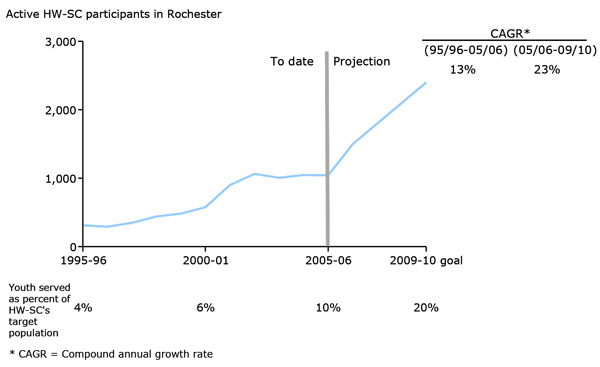
The team set about developing a detailed implementation plan, using their research learnings to inform specific initiatives and milestones and then assigning roles and responsibilities across the organization for each piece. The board led the way by making funding and jobs its top two priorities, and HW-SC committed to creating two new positions, one in each area, to ensure adequate staff attention could be focused on each. The clear path forward helped to establish a feeling of confidence among board and staff members that HW-SC could indeed achieve its goals of helping many more Rochester youth to graduate every year.
Making Change and Moving Forward
HW-SC is now on its way to solidifying the funding and employer relationships in its growth plan. The plan in and of itself has built momentum among key stakeholders in the community. Executive searches are underway to fill key senior positions at HW-SC that will be necessary to implement the plan. And the organization has made headway in establishing its first deep partnership with an area hospital: One of the hospitals that employed a single HW-SC youth during the 2005-06 school year has set a goal of increasing that number to 25.
While more legwork and organizational change will be required to deliver on the organization’s goals of doubling, the HW-SC team feels confident it is on its way to making a difference in the lives of hundreds more youth every year.
Appendix
History of the Hillside Work-Scholarship Connection
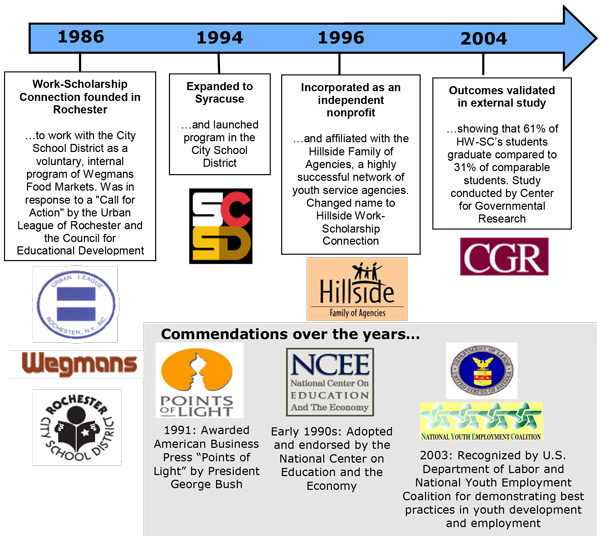
Sources Used for This Article
[1] New York State Department of Labor—Workforce Industry Data for the Rochester/Finger Lakes region; American FactFinder at www.census.gov
[2] New York State Department of Education
[3] Ibid
[4] The research study used controlled comparison groups and analyzed the performance of 1,250 HW-SC youth.
[5] Wegmans Food Markets, Rochester.
[6] Foundation Center maintains a comprehensive database on U.S. grantmakers and their grants. The database is available online at http://foundationcenter.org



